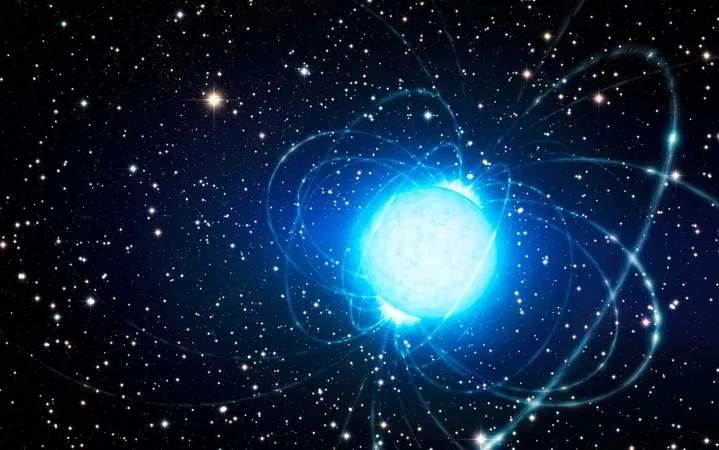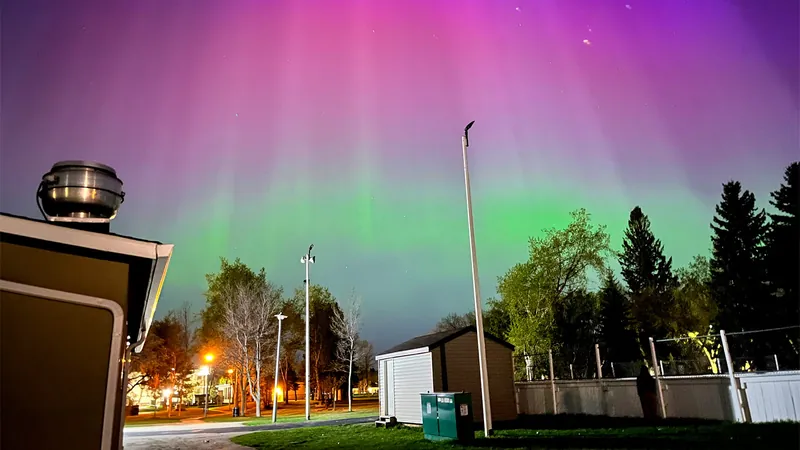
Unlocking the Secrets of the Universe: How Gravitational Waves May Explain Fast Radio Bursts!
2025-01-14
Author: Michael
Unlocking the Secrets of the Universe: How Gravitational Waves May Explain Fast Radio Bursts!
Fast radio bursts (FRBs) are one of the universe's most enigmatic phenomena, characterized by brief pulses of radio energy that can last anywhere from just milliseconds to a few seconds. While most FRBs originate from beyond our galaxy, an intriguing case has been identified from within the Milky Way itself—a powerful magnetar known as SGR 1935+2154, detected in 2020 as the first confirmed source of FRBs in our cosmic neighborhood.
Despite extensive research, the astrophysical processes behind FRBs remain shrouded in mystery. Scientists suspect a high-energy source, like those produced by magnetars, but solid evidence and clarity on their origins remain elusive. Enter the exciting world of gravitational waves (GWs)—ripples in space-time caused by massive celestial events—which could potentially provide answers.
Recent research, published in The Astrophysical Journal and led by A. G. Abac from the Max Planck Institute for Gravitational Physics, utilized the British-German GEO600 gravitational wave detector to search for connections between FRBs and GWs emitted by SGR 1935+2154. This groundbreaking study titled “A Search Using GEO600 for Gravitational Waves Coincident with Fast Radio Bursts from SGR 1935+2154” aimed to unveil whether gravitational hiccups accompany the FRB emissions from the magnetar.
Understanding the connection between FRBs and magnetars is critical. The energy released by magnetars—phenomenal stars with incredibly strong magnetic fields—often leads to phenomena like starquakes, which could theoretically produce gravitational waves at the same time as FRBs. James Lough, the lead scientist behind the GEO600 project, noted, “Detecting simultaneous FRBs and gravitational waves would be the powerful evidence we have long sought.”
From April 2020 to October 2022, SGR 1935+2154 experienced three episodes of FRBs while GEO600 was monitoring the skies. Despite the hope of linking these colossal cosmic events, careful data analysis yielded no evidence of associated gravitational waves. However, this lack of detection has not been in vain; being so nearby allowed researchers to gather valuable insights nonetheless.
This isn't the first instance of researchers trying to connect GWs emitted from magnetars with FRBs. Previous high-powered detectors like LIGO, Virgo, and KAGRA undertook similar attempts but also came up empty-handed. Interestingly, the lack of direct evidence has nonetheless helped refine theories surrounding the gravitational energy produced during such events. For instance, data revealed that any gravitational waves emitted during SGR 1935+2154's FRB episodes were likely up to 10,000 times less energetic than previously estimated.
As scientists continue their explorations, new models are emerging to explain how GWs are produced amidst the rapid releases of energy associated with FRBs. But our quest is far from over—the hope is that the upgraded capabilities of LIGO and Virgo will aid in future observations. Scientists are optimistic that if SGR 1935+2154 becomes active again, the enhanced sensitivity could uncover the elusive connection between these two cosmic phenomena.
Karsten Danzmann, director of the Albert Einstein Institute and the Institute for Gravitational Physics at Leibniz University Hannover, expressed enthusiasm: “Things could get exciting really soon. With the ongoing observing run lasting until June 2025, we are poised for more potential discoveries that could finally lift the veil on the long-standing mystery of fast radio bursts and their connection to gravitational waves.”
Stay tuned—future observations might just hold the key to understanding one of the universe’s most pressing questions! The cosmic dance of magnetars and FRBs is far from over, and as scientists press forward, the implications for our understanding of the universe epitomize the adventure of modern astrophysics. Will the mystery of FRBs finally be unraveled? Only time will tell!









 Brasil (PT)
Brasil (PT)
 Canada (EN)
Canada (EN)
 Chile (ES)
Chile (ES)
 Česko (CS)
Česko (CS)
 대한민국 (KO)
대한민국 (KO)
 España (ES)
España (ES)
 France (FR)
France (FR)
 Hong Kong (EN)
Hong Kong (EN)
 Italia (IT)
Italia (IT)
 日本 (JA)
日本 (JA)
 Magyarország (HU)
Magyarország (HU)
 Norge (NO)
Norge (NO)
 Polska (PL)
Polska (PL)
 Schweiz (DE)
Schweiz (DE)
 Singapore (EN)
Singapore (EN)
 Sverige (SV)
Sverige (SV)
 Suomi (FI)
Suomi (FI)
 Türkiye (TR)
Türkiye (TR)
 الإمارات العربية المتحدة (AR)
الإمارات العربية المتحدة (AR)